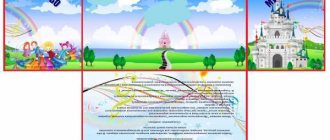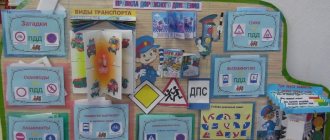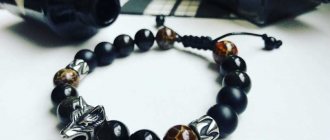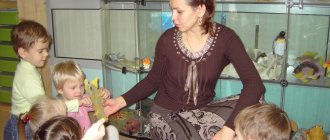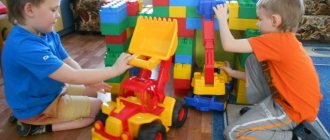On the topic: methodological developments, presentations and notes
Didactic games “Let’s collect beads for the doll”, “We’ll put on a sundress for the doll”
Objectives: To form an idea of the shape and color of objects. Introduce the six colors of the spectrum (yellow, green, blue, red, orange and purple), white and black. Development of small...
Goal: To strengthen children’s ability to recognize and name a cube, ball, brick; determine the size of objects, shape; color red, yellow, blue, green; group objects of similar shape and size...
Master class for preschool teachers “Use of the teaching aid “Beads” as a means of comprehensive development of preschool children
The master class shows the possibilities of using the teaching aid “Beads” in educational activities...
Summary of the didactic game on FEMP in the senior speech therapy group. In this game we focus children's attention on the color properties of objects. We teach children to understand the words “color”, “shape”, “same”, “not the same”, “different”. We also continue to teach children to work according to the model.
Didactic manual “Smart Beads” for children of primary preschool age
Do-it-yourself didactic manual for the younger group
Description of the material: games and exercises for the development of fine motor skills are a powerful means of maintaining the tone and performance of the cerebral cortex. Thanks to them, children improve their attention, memory, auditory and visual perception, speech, and develop perseverance. Their future successful learning depends on how dexterous and developed children’s fingers are by the age of 5–6 years. To develop fine motor skills of your fingers, you don’t have to buy expensive toys in the store; they can be made at home from scrap materials. The material will be useful for teachers and parents. I created a teaching aid “Smart Beads” from waste material.
The colorfulness and novelty of the book attracts children's attention and stimulates the desire to play with it. I tried to develop educational games in such a way that they could solve several educational problems. Such as consolidating knowledge of colors and the ability to use generalizing words in children’s speech. The manual is multifunctional. The process of making the manual: 1. Take containers from Kinder surprises.
2. Open them and cut off the excess part on one of the halves so that the lids are the same size.
3. Cut circles from the ceiling tiles of a size equal to the diameter of the container lid.
4. Insert the mugs into the lids.
5.Make holes on opposite sides.
6. Find pictures on various lexical topics on the Internet. Reduce them to the size of circles and glue them with double-sided tape. Choose colored laces for the manual.
Didactic game “Collect beads on a topic”
Goal: development of fine motor skills of the fingers, the ability to select subject pictures on a lexical topic / “Pets”, “Wild animals”, “Vegetables”, “Fruits”, “Dishes”, “Furniture”, “Toys”/, consolidation of color knowledge. Progress of the game: the teacher invites the children to collect beads and determines a theme for each. Children complete the task independently.
To check whether the beads are assembled correctly on the topic, the teacher suggests turning the beads over to the other side (if the beads are the same color, then the task was completed correctly. If not, then a bead of a different color will signal an error that needs to be corrected)
Didactic game “Stringing beads of a certain color”
Goal: development of fine motor skills of the fingers, consolidation of color knowledge, the ability to select a generalizing word. Progress of the game: the teacher asks the child to put, for example, red beads on a cord.
Then he offers to turn the beads over and look at the pictures. The child lists the names of objects. Then the teacher asks to name the pictures in one word.
Didactic game “Find the extra bead” (by color or by lexical topic)
Goal: development of fine motor skills of the fingers, attention, logical thinking; consolidation of color knowledge. Progress of the game: the teacher invites the child to carefully examine the beads on the cord and determine which bead is different from the others (different in color).
Then he asks to correct the error. Didactic game “Alternating beads by color”
Goal: the ability to alternate beads by color, identifying a pattern; development of attention and fine motor skills of the fingers. Progress of the game : the teacher invites the child to continue stringing the beads, alternating them by color.
The child comments out loud with the help of the teacher: “First a red bead, then a white one. Then red, again white. I take the red one again, and then the white one.” Didactic game “Choose a lace by color”
Purpose: development of fine motor skills of the fingers, attention; consolidation of color knowledge. Progress of the game: (the beads lie with the colored side up) The teacher invites the children to select the cord of the desired color and string the beads on it.
Then everyone checks together. -What color are the beads? (red) -What color is the lace? (also red) - Well done. This means the task was completed correctly. Didactic game “Pick up a number”
Goal: ability to correlate the number with the number of beads within 5; development of fine motor skills of the hands. Progress of the game: the teacher invites the children to independently collect beads on any topic.
Children agree among themselves which topic they choose. The teacher is interested in what topic each child’s beads are collected on, and together they check the correctness of the work. Then the teacher asks how many beads each child has on the cord and asks to match the number of beads to the required number. Didactic game “Riddles”
Purpose: development of fine motor skills of the fingers; the ability to solve riddles and select a generalizing word. Progress of the game: (lexical topic is chosen at will, for example, a game on the topic “Pets”). The teacher asks the child to guess the riddle, choose a bead with the answer and put it on a cord. Riddles: 1. The nose is a snout, the tail is a hook.
Who is this? /pig/ 2.
I clatter my hooves. I gallop very quickly.
The mane curls in the wind, I can’t resist /horse/ 3.
Hungry, mooing, Full, chewing.
The little guys are given milk by the cow/ 4.
The muzzle is mustachioed, the fur coat is striped.
He washes his face often, but doesn’t know how to use water. /cat/ 5.
Beard and horn Run along the path /goat/
Then the teacher can offer to answer additional questions. -What one word can you use to describe who this is? (pets) -Which animal is first? (horse) -Who's last? (goat)
We recommend watching:
Didactic game for children from 1 to 5 years old “Family Hobbies” Didactic game on sensory skills for kindergarten Do-it-yourself multifunctional game guide for preschoolers Didactic guide for kindergarten “Shoes quarreled, shoes made peace”
Similar articles:
Do-it-yourself didactic games for preschoolers on the topic “Sense Organs”
DIY didactic game for preschoolers. World of flora and fauna
Do-it-yourself didactic game for kindergarten on the topic “Transport”
DIY didactic game for preschoolers
Didactic game for children 4-7 years old “Fairytale Hotel”
Card index of didactic games
CARD INDEX
DIDACTIC GAMES
Didactic game “Fix the rug”
Target:
Strengthen the ability to select objects of two given sensory properties - shape and size, develop the skills of applying and applying for self-test; consolidate skills about geometric shapes.
Material:
rugs of primary colors, with slots of different shapes and sizes (circle, square, triangle); geometric shapes of primary colors (circles, squares, triangles), suitable “for covering holes” on the rug.
Progress of the game:
The teacher says: “Look at the rugs the bunnies brought us, beautiful, bright ones, but the mice ruined these rugs. The bunnies now don’t know what to do with them. Let us help them patch (repair) the rugs. What color are the rugs? What patches will we put on the rugs? The children are given a rug, and by applying the technique, the children “close the holes” by selecting geometric shapes by color and shape.
Didactic game "Balloons"
Target:
Develop the ability to distinguish and name primary colors (red, yellow, green, blue), fix and name the size of a figure; learn to compare geometric shapes by color and size, finding signs of similarity and difference and reflecting them in speech; develop fine motor skills of the fingers.
Material:
The balls are different in color and size, the ribbons are different in width and color.
Progress of the game:
Children, the doll “Katya” came to visit us today. She wants to play with you. Katya came to us with a magic box. Let's see what's in the box.
-Look, there are balloons here!
- What kind of balls?
— What color?
Children look at the balls and name the color and size.
- “Arrange the balls by color”
— «
Collect all the big balls (small, medium)"
— «
Find all the red (yellow, blue, green) balls.
-Look, the Katya doll brought us more beautiful ribbons. The ribbons are examined, the children name the color, size (long, short). Choose a ribbon for each ball according to color and size.
Didactic game “Tie a string to the ball”
Target:
grouping objects by color
Material:
Multi-colored balls cut out of cardboard (ovals or circles); cut strips of the same colors.
Progress of the game:
Invite the children to look at the balls. Find a string (stripe) for the balls, find a red strip for the red ball, find a green strip for the green ball, etc.
Didactic game "Granny's pancakes"
Target:
To promote the development of comparison skills, the ability to systematize objects according to a certain criterion.
Material:
Cut out several circles with a diameter from paper
3 cm, and several circles with a diameter of 6 cm, a plate for large circles, a plate for small circles.
Progress of the game:
Educator: Grandma was baking pancakes (large and small). Large pancakes are for mom and dad, and small pancakes are for the grandchildren. But all the pancakes got mixed up. We need to help grandma put the pancakes on plates.
Didactic game “Hide in your palm”
Target:
Develop the ability to correlate objects by size
Material:
Small and large balls.
Progress of the game
: Give the kids balloons. Say: “Now I’ll show you a trick!” Take a small ball and hide it in your palm. Ask the children to do the same. Invite the children to repeat the trick with a large ball. Explain why a large ball cannot be hidden in the palm of your hand. Compare the balls with each other, then with the baby’s palm. You can perform similar tricks with any small objects.
Didactic game “Pick up the lid”
Target:
Develop skills in classifying and comparing objects.
Material:
Pots with lids
Progress of the game:
Invite your child to cook lunch together for the dolls. Take three pans large, medium, small. Say that we will cook soup in a large saucepan, porridge in a medium one, and compote in a small one. Find out what vegetables we need to prepare the soup, and what we will use to make the compote. Then tell your child that the lids from the pots are mixed up and that you don’t know which lid is from which pan. Ask your child to help choose the right size lids.
Didactic game “Hand out the plates”
Target:
Introduce children to the concepts of “many”, “few”, “one”,
" one by one".
Material:
4 plates, 4 toys (bear dolls, etc.)
Progress of the game:
Offer the child to feed the toys.
Give your child a stack of plates. Draw his attention to the number of dishes, using the words “a lot”, “a whole stack of plates”. Ask to distribute one plate to all dolls. At the same time, comment on the child’s actions: The bear was given a plate, now the bear has one plate; The bunny was given a plate and the bunny now has one plate, etc. After distributing the dishes, draw a conclusion: “They handed out a whole stack of plates, and everyone had one plate. Now let's put the plates back together. Look, you have a lot of plates again.
Didactic game “Fungus to Fungus”
Target:
Promote the development of fine motor skills, teach to correlate quantitative sets, help master the concept
"as much as"
Material:
5 yellow and 5 red mushrooms cut out of cardboard.
Progress of the game:
Invite your child to choose mushrooms. Explain the rules of the game. Then the adult lays out one mushroom, and the baby should put his own mushroom under it. Draw the child’s attention to the fact that the figures should be laid out from left to right. This will allow the child to acquire the skills necessary in the future to write correctly. After laying out all the mushrooms, comment:
“I put 5 mushrooms, and you put 5 mushrooms, which means there are as many of your mushrooms as mine, they are equally divided. You can use cubes of two colors.”
Didactic game “Help the harvest”
Target:
Promote the development of classification skills.
Material:
Models or pictures depicting vegetables and fruits, 2 baskets.
Progress of the game:
Arrange vegetables and fruits (or pictures with their images) interspersed. Ask your child to collect and put vegetables in one basket and fruits in another basket.
Didactic game “Match the cup to the saucer”
Target:
Teach children to name and distinguish red, yellow, blue, green colors. To develop the ability to correlate an object and its color. Develop auditory attention.
Material:
templates of cups and saucers, four primary colors (red, blue, yellow, green).
Game description:
The teacher shows the children a beautiful box and invites them to find out what is in it. Then the children are given saucers. The cups are laid out in the middle of the table. The task is to match the saucer with a cup of the same color. After completion, each child names the color of the cup and saucer, making sure that the colors match. Then the children change the saucers once and again match the cups to them. So the game is repeated several times.
Didactic game “Find the same mittens”
Target:
Learn to find an object by similarity, develop visual memory, auditory attention, intelligence, cultivate observation skills, and interest in games.
Material:
Made mittens of different colors and patterns.
Progress of the game:
Give the children one mitten each and say: “The second mitten is lost, you need to find it.” We’ll search based on the signal, and now we’ll walk around the group.” Children are walking. The words of the teacher are heard: “One - two - three - find a pair of mittens!” Everyone should become with the child who has the same pattern on his mitten.
Didactic game “Find the same mittens”
Target:
Teach children to compare geometric shapes by shape, color, and practice naming them. Teach children to quickly find the desired figure, develop children’s ability to distinguish and correctly name geometric figures.
Material:
Pairs of mittens for each child, depicting geometric shapes of different colors.
Progress of the game:
We distribute one mitten to the children, and lay out the second mitten on the table (you can put the second mittens on the carpet). While listening to music, children walk around the group; when we stop the music, the children must find their second mitten. We ask everyone what geometric figure is on his mitten.
Didactic game “Make pairs of subject pictures”
Target:
Learn to distinguish and compare object pictures with each other, name them correctly, develop the ability to concentrate.
Material:
Paired subject pictures.
Progress of the game:
Invite the children to look at the pictures and name the objects that are depicted. Please note that the pictures are repeated, i.e. are paired. Show how to find a pair of identical pictures. Invite the children to complete the task.
Didactic game: “Continue the row”
Target
: To develop the ability to select lids based on sensory attributes; develop visual perception and fine motor skills.
Material:
Colored lids
Progress of the game:
Invite the children to look at the colored caps, ask them to name the color, then invite the children to continue the row of caps.
Didactic game “Match a picture by color”
Target:
Consolidate knowledge of 4 colors, develop visual perception.
Material:
Lids with glued subject pictures and colored circles.
Progress of the game:
The teacher shows the children, for example, a lid with a yellow circle, asks what color it is and invites the children to choose an object picture of the same color. Then he shows the lid with a green circle, the children name the color and also select the picture.
Didactic game “Make beads for the doll”
Target:
Develop the ability to select an object by color (what color is the lace. Beads (tubes) should be the same color), develop the ability to alternate beads of two colors; improve coordination of finger movements, develop an eye.
Material
:
Cords in primary colors (red, yellow, blue), wooden beads (painted in primary colors red, yellow, blue, green) or cut cocktail tubes.
Progress of the game
: Children are invited to make beads for the dolls.
Select beads or tubes according to the color of the lace.
Alternate beads of two colors (red - yellow, green - blue, etc.) at the request of the children.
Children randomly choose laces, beads (tubes), and, at the request of the teacher, name the color of the lace or beads.
Didactic game “Pick up the key to the lock”
Target:
To develop the ability to correlate the form and the liner; develop visual coordination and motor skills; consolidate knowledge of primary colors; develop attention and speech.
Material:
Cardboard frame in the form of a castle, a set of inserts (geometric shapes).
Progress of the game:
The mouse invites the children to go to the fairy tale where he lives, but to do this they need to open the magic door to which the key has been lost. It must be found, picked up.
Didactic game
“Match the leaves to the tree”
Objectives
: To form knowledge about color, size, to develop visual perception, thinking, attention, memory; develop fine motor skills of the hands, develop speech.
Target
: Teach children to distinguish colors (yellow, red, green), develop the ability to correlate leaves by color.
Material:
Three trees of primary colors and leaves (yellow, red, green) cut out of cardboard.
Progress of the game:
A strong wind blew and all the leaves flew away. Let's collect the leaves and place them on the trees of the corresponding color so that the leaves are the same color as the tree.
Didactic game
“Big and small leaves”
Purpose:
Teach children to distinguish leaves by size, consolidate the concepts: big - small.
Material
: Multi-colored leaves, different in size.
Progress of the game:
A strong wind blew and all the leaves fell to the ground. The teacher offers to collect the leaves. All large leaves go into a large basket, and all small leaves go into a small basket.
Game “Show and name the leaf”
Target:
Teach children to show leaves by word denoting color, size; strengthen children’s ability to distinguish and name colors (yellow, green, red); consolidate the concept of “big” and “small”.
Material:
Cut out large and small leaves of primary colors (yellow, green, red).
Progress of the game:
Offer to look at the leaves, then ask the children to find a leaf with a certain color and size.
- “Show me the big red leaf”
- “Show me a little green leaf,” etc.
Didactic game
“What has changed”
Purpose:
Develop visual perception, memory, speech, attention.
Material:
Cut out leaves of different shapes and colors.
Progress of the game:
Place several different pieces of paper (3-4 pieces) on the table. Invite the children to close their eyes. The teacher removes or swaps the leaves.
- " What changed?"
Didactic game
“Collect leaves”
Purpose:
Develop children's constructive skills, visual attention, creative imagination, and thinking.
Material:
Leaves of primary colors, different in size (cut into two parts)
Progress of the game:
Guys, look how many leaves have fallen from the trees. Let's collect them (An adult suggests collecting leaves from parts, noting that the leaves are of different colors and sizes). Children fold the leaves; if the children do not cope with the task, then together with the child, fold the halves of the leaves to make whole ones. You can ask which leaf you got ( big or small, what color).
Didactic game
“With nesting dolls”
Purpose
: Teach children to memorize geometric shapes. Teach grouping objects by color, correlating objects by shape using the overlay method. Improve tactile sensations. Develop fine motor skills of the hands. Teach children to focus on the color properties of objects.
Material: 4 nesting dolls with geometric patterns - diagrams, geometric shapes of primary colors (circles, squares, triangles, rectangles), paths, buckets of primary colors)
1. “Dress up the nesting doll”
Progress of the game:
Invite your child to decorate the matryoshka dress with geometric shapes. The child takes any matryoshka doll and, using the overlay method, lays out geometric shapes along the contour; the color of the geometric shapes should match the color of the matryoshka scarf. The game is considered complete if all the contours are covered with geometric shapes.
2. “Track for a nesting doll”
Progress of the game:
Invite your child to lay out a path for the matryoshka doll. The child takes a “path” with a geometric figure, the same color as the matryoshka doll, lays out geometric figures of the same shape and the same color. The game is over when all the pieces are placed on the track until the entire track is full.
3.
“Find the Matryoshka bucket”
Game progress
: The teacher says that the nesting doll wants to go get water, but doesn’t know where her buckets went. Let's help the nesting doll find her buckets. Children are looking for buckets (the buckets must match the color of the nesting doll).
Didactic game “Colored peas”
Target:
Training and consolidation of knowledge of four colors (red, blue, green, yellow). Development of fine motor skills, the ability to group objects by color.
Material:
knitted pea pods of primary colors (red, yellow, green, blue) with locks, knitted peas of primary colors (each pod has 3 large and 2 small flowers), a knitted rug with multi-colored squares of primary colors.
Option 1:
Progress of the game:
Guys, look how beautiful the peas are. Peas love to play, but they can only play on a rug of their own color. You need to arrange the peas into squares, by color. Peas and squares must be the same color.
If the child is at the initial stage of learning colors, then instead of a whole carpet, you can offer stripes with alternating two colors.
Option 2:
Progress of the game:
All the peas are mixed on the table. Guys, look, the peas are lost, they cannot find their houses. Let's place the residents of the “pea” in their “pod” houses and lock them so that they don’t run away again. Be careful, the peas are different in color and the houses are also different, each pea lives in a house of its own color.
Didactic game “Visiting the little figures”
Target:
Familiarize children with geometric shapes: circle, square, triangle, rectangle. Learning how to examine a form - tracing the outline of a figure with your fingers.
Material:
Cut out of cardboard: a circle, a square, a triangle, a rectangle with painted “faces”—little figures.
Also smaller geometric shapes, different colors for each child.
Progress of the game:
The teacher, together with the children, examines a circle, square, triangle, rectangle, traces their outline with a finger, and gives the names of these figures. Then the game is played.
Guys, human figures came to us today.
They baked it in the oven
Sweet cookies,
It turned out delicious
Simply delicious!
But they had a problem, the cookies scattered and got mixed up. Figures - little men are asking for help, let's help them collect the cookies.
Each figure collects cookies (multi-colored: circles, squares, rectangles, triangles) in a plate of the same shape as itself.
"GET IN ORDER"
Target:
Teach children to distinguish colors and use the names of colors in speech. Learn to understand the words “such”, “not such”, “different”. Develop fine motor skills.
Material:
Cut colored foam cubes (red, yellow, green, blue); 4 colored plates of primary colors, tweezers.
Progress of the game:
Children collect colored cubes scattered on the table and place them on plates of the corresponding color. While pronouncing the color of each cube.
